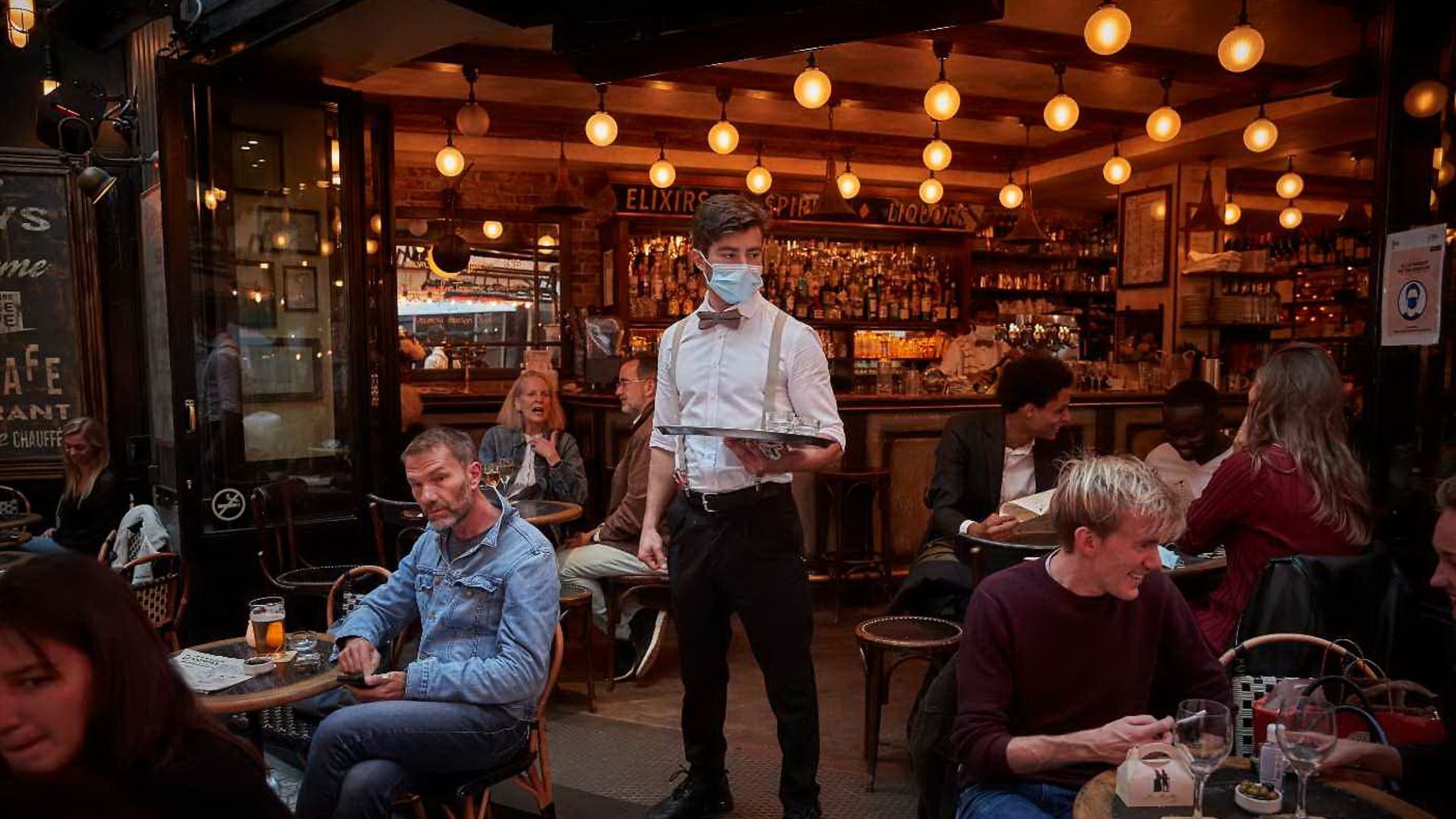
France’s is bailing out its wine industry, which has been hit hard by the pandemic. But, says JASON WALSH, long-standing social trends in the country could be even more troubling for the sector.
The scene outside Le Ballon Vert in the trendy 11th arrondissement of Paris: forced outdoors by post-coronavirus regulations and unseasonal autumn weather, groups of young and not-so-young friends whiled away an hour or two talking over their favourite drink. Beer.
Not coincidentally, France’s most famous export industry, and a longtime domestic stalwart, winemaking, is on the ropes.
Le Ballon Vert is an Irish pub, though, and an authentic one at that; not a chain that arrived, complete with spray-on faux nicotine coloured paint, fiddles and bodhráns, to be unpacked from a lorry. Surely customers at an Irish pub, even when they are French, are more likely to sink a pint of the black stuff than sip a glass of Bordeaux?
Perhaps. But just across the road at Au Petit Panisse the picture is quite the same: beer dominates while most of the white wines are in the hands of those with white hair.
The scene is duplicated across France. One bar owner – a traditional French café in this case – tells me that more of his customers drink lager than wine.
It’s not like the French are new to beer, of course, and there are significant regional variations with northern France, particularly those areas close to the land of beer, Belgium, always having been more fond of an ale.
However, clearly something is changing. Most supermarkets now stock a limited range of craft beers alongside the more traditional varieties sold in France: tasteless generic euro-lagers and Belgian rocket fuel, strong enough to cause hangovers before you even sober up, now compete with local and imported IPAs, and even with African Guinness (yes, really).
Meanwhile, specialist shops like Paris Saint Bière, stock a variety of ales large enough to curl a hipster’s beard.
But if observations are one thing – I noticed a surge in the summer sales of rosé about three years ago, though it has tailed off somewhat since – statistics back them up. Students horsing into cheapo happy hour pints and post-lockdown drinks aside, there are both short- and long-term trends at work.
It was widely reported that home drinking rose during France’s lockdowns, but this has done little to save viniculture: bar and restaurant closures resulted in losses of an estimated 1.5 billion euros.
Over a decade ago a University of Montpellier study noted that the French were drinking less wine than ever: total per capita consumption collapsed by more than 50% between 1980 and 2008, from over 120 litres annually per person to just 55.
Today, that trend has slowed but decline continues, with statistics from the International Organisation of Wine showing that in 2017 the average French citizen drank 51.2 litres per year.
Production is down, too. Last year saw a decline of 12%. Predictions for 2020 expect a 6% to 8% rise on last year, but the long term trend points downward.
The fact that this year wine has been used to make hand sanitiser is a mixed blessing for wineries: it brought in much-needed cash, but seeing their famous product turned into a sanitary item surely stings.
The pandemic will sting more, though. While bars and restaurants have reopened following the lockdown, rising infection rates – September 24 alone saw 16,096 cases reported, a new and unwelcome daily record – another round of restrictions introduced this week mean on-premise alcohol sales will stop at 10pm in Paris, while publicans and restaurateurs in Marseilles have taken to the streets to protest against the local lockdown that forces all hospitality businesses to shut up shop.
Paris is also considering curbing home drinking, with murmurs of an 8pm curfew on off-sales.
All of which is bad news for France’s chateaux, though France’s government recognises the problem: with millions of hectoliters of wine lying unsold, prime minister Jean Castex announced a second bailout for the viniculture sector, raising the total figure to 250 million euros.
Still, exacerbated though they are by the pandemic, the industry’s troubles predate coronavirus – as those drinking habits statistics underline. It’s not just a growing taste for beer that is to blame. Social trends are just not flowing in wine’s favour.
President Emmanuel Macron declared last year “Me, I drink wine at lunch and dinner!”. If he does, he is one of a dwindling band.
When I was working in a French workplace I noticed the canteen was well stocked with wine. But I never saw anyone drinking it. Of course, this is in line with cultural changes across much of the western world: Lunchtime O’Booze pretty much came to an end in my home country of Ireland in the 1990s, while a colleague in London tells me that even members of my own benighted trade are today a sober lot: journalists these days are as likely to hang out at the gym than have their heads in the trough at the Pig and Bucket.
France, with its very particular and deep-rooted drinking culture, is also losing some of its quirks. The tradition of parents serving diluted wine to children has dwindled. Schools stopped serving wine in 1981, and had been discouraging it since the 1950s at least. More and more French young people just aren’t developing a taste for wine.
Indeed, this may explain why when young people do drink wine it is often rosé or sweet whites rather than dry whites or classic reds.
As if all that wasn’t enough, other factors are crushing the wine industry underfoot.
Donald Trump slapped a so-called “luxury tax” on French wine as part of a new front in his tit-for-tat trade wars, while recent decades have seen Italian reds steal the crown from French chateaux in the fine wines sector. Brexit, meanwhile, threatens a second of the three key export markets for Bordeaux: the UK.
Both of these threaten to cement a long term trend away from French wine. Famously, the Judgement of Paris in 1976 dealt a severe blow to the reputation of French wine, and to that of wine critics, that the country has never fully recovered from: this blind test competition backfired when it turned out that critics preferred Californian wine to French.
Since then wine consumption has risen in countries like Britain and the US, and while French wine still has cachet at the top of the market, many supermarket drinkers prefer ‘new world’ or Italian wines.
Tastes play a part in this, with simpler wines from other parts of the world beating out French produce (for my money you just can’t beat a good French wine, but I am perhaps biased). Marketing helped, too, with French wine’s terroir system seen as needlessly complicated – though why lists of regions should be considered any more arcane than lists of grape varieties is anyone’s guess.
In the longer term French winemakers may be facing an even graver threat than taxes and inverted snobbery: climate change. Naturally, French agricultural research body Inrae has been keeping an eye on the situation.
Nathalie Ollat, director of the Ecophysiology and Vine Functional Genomics unit at Inrae’s New Aquitaine Bordeaux centre told me that climate change has been affecting vine development since the 1980s, principally by causing a faster ripening and a higher sugar, and hence, alcohol content.
The news isn’t all bad, though. “For the time being, however, the effects have been considered rather beneficial in many wine-growing regions, with a greater threat in the vineyards of the south of France due to the already high degrees and more frequent droughts,” said Ollat.
Still, Ollat cautioned that this is not a simple story of warm weather meaning more wine. For a start, there is a threat to vineyards of the south due to the already high temperatures and more frequent droughts.
“But there are also more frequent spring frosts in some regions such as the Loire Valley, because the vines are ahead of schedule, and in some years, such as 2019 in the Languedoc, intense heat waves in early summer that can cause severe burns on the grapes,” she said.
There have been reports that 2020 saw harvests a month earlier than usual, leading winemakers to worry that if trends continue eventually Spanish grapes will grow in the UK – and not grow on the French-Spanish border regions. There is even the possibility that, in time, French chateaux may have to change the grapes they use. French viniculture is not quite as conservative as people think, but it is proud of its traditions. If changes to centuries-long blends of grape varieties may become necessary that would challenge the very nature of French wine.
“These changes overturn the rules and customs in force. They raise questions about how to maintain the French viticultural model. But professionals are mobilised to deal with them,” said Ollat.
The trouble for this totemic French industry, however, is that it will have to cope with not just adverse climate trends, but social ones too.









